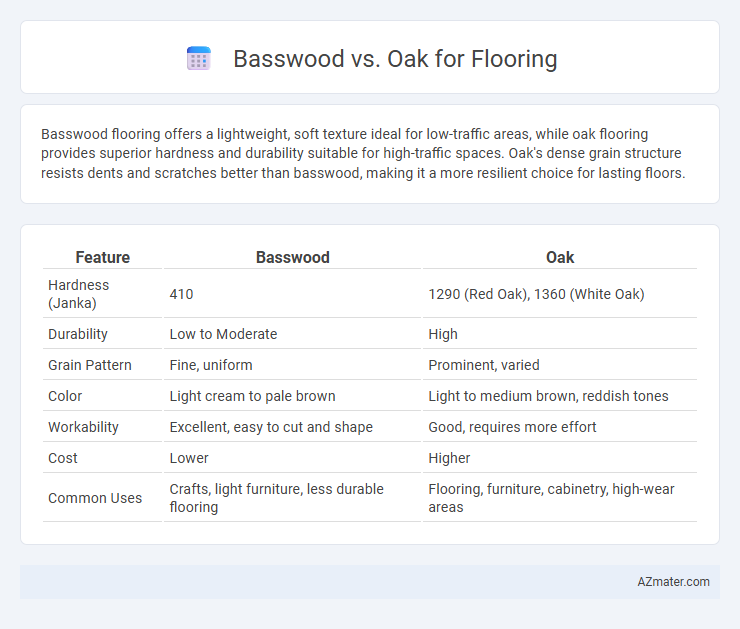Basswood flooring offers a lightweight, soft texture ideal for low-traffic areas, while oak flooring provides superior hardness and durability suitable for high-traffic spaces. Oak's dense grain structure resists dents and scratches better than basswood, making it a more resilient choice for lasting floors.
Table of Comparison
| Feature | Basswood | Oak |
|---|---|---|
| Hardness (Janka) | 410 | 1290 (Red Oak), 1360 (White Oak) |
| Durability | Low to Moderate | High |
| Grain Pattern | Fine, uniform | Prominent, varied |
| Color | Light cream to pale brown | Light to medium brown, reddish tones |
| Workability | Excellent, easy to cut and shape | Good, requires more effort |
| Cost | Lower | Higher |
| Common Uses | Crafts, light furniture, less durable flooring | Flooring, furniture, cabinetry, high-wear areas |
Introduction: Comparing Basswood and Oak for Flooring
Basswood and oak are two popular hardwood options for flooring, each offering unique characteristics that influence durability, appearance, and cost. Oak is renowned for its strength, rich grain patterns, and long-lasting performance, making it a preferred choice in high-traffic areas. Basswood, while softer and lighter in color, provides a smooth texture and is often favored for its affordability and ease of staining to achieve various finishes.
Key Characteristics of Basswood and Oak
Basswood flooring is prized for its softness, lightweight nature, and fine, uniform grain that allows for easy staining and a smooth finish, making it ideal for rooms requiring a warm, subtle appearance. Oak flooring boasts exceptional hardness and durability, with a prominent grain pattern that provides a rustic, textured look, suitable for high-traffic areas and long-lasting wear. Both woods differ significantly in Janka hardness ratings, with oak typically scoring around 1290-1360 compared to basswood's softer 540, influencing maintenance and lifespan in flooring applications.
Durability and Hardness Comparison
Basswood flooring offers moderate durability with a Janka hardness rating around 410, making it softer and more prone to dents and scratches compared to oak. Oak flooring, particularly red or white oak, has a significantly higher Janka hardness rating of approximately 1,290 to 1,360, providing superior resistance to wear and impact. For high-traffic areas, oak's toughness and durability make it a more practical and long-lasting flooring choice than basswood.
Appearance: Color, Grain, and Texture Differences
Basswood flooring features a pale, creamy color with subtle, fine grain patterns that create a smooth, uniform texture ideal for minimalist and modern interiors. Oak flooring offers a richer range of hues from light amber to deep reddish-brown, characterized by prominent, coarse grain patterns that add warmth and visual depth to traditional or rustic spaces. The distinct texture differences--basswood's soft, even surface versus oak's pronounced grain relief--allow for diverse aesthetic applications based on desired room ambiance and design style.
Cost Differences: Basswood vs Oak Flooring
Basswood flooring typically costs less per square foot compared to oak, with prices ranging from $3 to $6 for basswood and $5 to $10 for oak, depending on quality and finish. The lower density of basswood contributes to reduced milling and installation expenses, while oak's durability and hardness often justify its higher price point. Homeowners seeking budget-friendly options generally choose basswood, whereas oak is preferred for long-term investment due to its resilience and classic appearance.
Installation: Ease and Techniques for Both Woods
Basswood flooring offers easier installation due to its softer texture and lighter weight, allowing for quicker cutting and nailing with standard tools. Oak, being denser and harder, requires more precision and durable equipment, often necessitating pre-drilling or pneumatic nailers to prevent splitting. Both woods are compatible with tongue-and-groove techniques, but basswood's pliability results in smoother alignment and fewer installation challenges.
Maintenance and Longevity Considerations
Basswood flooring requires less maintenance due to its softer texture, making it more susceptible to dents but easier to refinish and repair over time. Oak floors, known for their exceptional hardness and durability, provide superior longevity with minimal upkeep, resisting wear and scratches more effectively than basswood. Choosing oak ensures a longer lifespan and less frequent refinishing, while basswood offers a budget-friendly option with manageable maintenance needs.
Environmental Impact and Sustainability
Basswood flooring offers a more sustainable option due to its fast growth rate and efficient carbon sequestration compared to oak, which grows slower and requires more intensive resource management. Oak, while durable and long-lasting, demands higher energy inputs for processing and often involves more extensive forestry practices impacting biodiversity. Choosing basswood reduces deforestation pressure and promotes a lower carbon footprint, aligning with eco-friendly flooring solutions.
Best Uses: Where Each Wood Excels
Basswood flooring excels in light-traffic areas and indoor spaces due to its softness and ease of machining, making it ideal for decorative purposes and rooms requiring a warm, light aesthetic. Oak flooring is best suited for high-traffic areas such as hallways, kitchens, and commercial spaces because of its exceptional hardness, durability, and resistance to wear. The dense grain and strength of oak make it perfect for long-lasting flooring solutions, while basswood is preferable for lighter, less demanding applications.
Conclusion: Choosing Between Basswood and Oak for Your Floor
Basswood offers a softer, lighter option with a fine, uniform grain, ideal for low-traffic areas or budget-friendly projects, while oak provides superior hardness, durability, and a more pronounced grain pattern suited for high-traffic spaces. Oak's higher Janka hardness rating (1,290 for red oak, 1,360 for white oak) makes it more resistant to dents and scratches compared to basswood's softer rating around 540. Selecting between basswood and oak flooring depends on balancing aesthetics, durability requirements, and maintenance preferences for your specific living environment.

Infographic: Basswood vs Oak for Flooring
 azmater.com
azmater.com